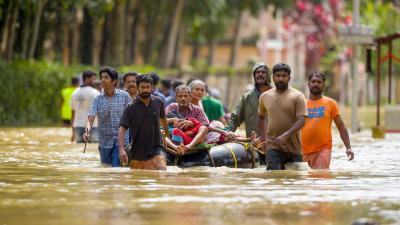High experience of disasters often correlates with low resilience
This page is approximately a 4 minute read
This page was published on

The 2021 World Risk Poll reveals that many countries and regions with high disaster experience are also those with low resilience, highlighting areas of vulnerability among communities where action is needed to make people safer.
On average, countries where people are more likely to have experienced disasters score lower on the World Risk Poll Resilience Index, which provides a summary score of how prepared they are to deal with hazards.
Australia/New Zealand (0.66), Northern America (0.65), South-east Asia (0.65), and Northern/Western Europe (0.64) are the most resilient regions according to the Index. In contrast, the least resilient region is Central / Western Africa (0.44), with people there most likely to say they have experienced a disaster caused by flooding, at almost two in five (17%).
A Resilient World? Understanding vulnerability in a changing climate
Read the reportExperience of disasters
At a global level, over a quarter (27%) of the world’s population has experienced some type of disaster in the past five years. These are most commonly caused by flooding or heavy rains – experienced by one in 10 people (10%) worldwide – while just over half (52%) of people globally said they had the ability to protect themselves or family in the event of a disaster.
The findings show that there is an unequal global distribution of disaster experience, including those caused by severe weather events, with the Middle East and South-east Asia particularly exposed. Disaster experience rises to more than a third (36%) in both the Middle East and South-east Asia, with the most commonly experienced disaster causes being earthquakes in the Middle East (19%) and floods in South-east Asia (15%).
At the other end of the scale, only 9% of people in Central Asia and 15% in Northern/Western Europe have experienced a disaster from a natural hazard in the past five years.
People who had experienced disasters from natural hazards were more likely than those who had not to view climate change as a ‘very’ or ‘somewhat serious threat’ to their country — 74% versus 65%, respectively. Those who had experienced droughts or wildfires were most likely to say climate change is a very serious threat.
By understanding how prepared and resilient individuals believe their communities, countries, and institutions are in dealing with disasters, we can share insight with governments, development agencies, businesses, and researchers to help them identify vulnerabilities and take action to make people safer.
Similarly, the Poll shows an unequal global distribution in how resilient countries and regions are to natural hazards. Regions where respondents reported higher satisfaction with infrastructure, and greater economic security typically scored relatively high on the World Risk Poll Resilience Index.
In just 14 of the 121 countries and territories polled did more than half of people say they have a plan that all family members know about in case of a disaster. Among these, seven — including the only three where at least 70% said they have a plan – were in South-east Asia.
South-east Asia stands out as a region that is prone to natural hazards, but also where people are prepared to protect themselves. The region’s high focus on disaster planning has led to coordinated efforts to develop proactive risk management systems. This regional focus on responding to natural hazards is a likely factor in why South-east Asians say they have a disaster plan for their household.
Having internet and phone access was also linked to people’s perception that they could act in the event of a disaster. In all country income groups, individuals who said they have internet access were more likely than those who do not to feel they could protect themselves and their families.
However, while having internet access is the norm in high-income (91%) and upper-middle-income (81%) countries, just 43% of people in lower-middle-income countries and 27% in low-income countries said they have internet access, highlighting the importance of extending access to this vital disaster lifeline.
Countries that have high disaster experience and countries with low resilience.
Have you personally experienced a disaster in the last five years?
Download the report

A Resilient World? Understanding vulnerability in a changing climate
Revealing how people worldwide feel their country’s infrastructure and government can cope in the face of disasters, the report provides global insights into how prepared and resilient individuals believe their communities, countries and institutions are. (PDF, 5.46MB)
